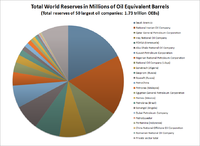
Photo from wikipedia
Groundwater is essential for regional ecological-economic system and is an important resource of drinking water, especially in the Chinese Loess Plateau (CLP), where is a typical water-limited ecosystem. Groundwater quality… Click to show full abstract
Groundwater is essential for regional ecological-economic system and is an important resource of drinking water, especially in the Chinese Loess Plateau (CLP), where is a typical water-limited ecosystem. Groundwater quality deterioration will affect water security and exacerbate the water shortages. Groundwater hydrochemistry, pollution source apportionment, quality and health risks were evaluated based on analysis of major ions and selected trace elements in seasonal samples of the Fen River Basin (FRB) in the eastern CLP. Groundwaters in the FRB were mainly HCO3--Ca2+-Na+ water type with low dissolved solutes in upstream samples, high values in midstream samples and medium values in downstream samples. Solutes in upstream samples were mainly derived from carbonate weathering, while those in midstream and downstream samples came from silicate weathering, evaporites dissolution and anthropogenic sources. Self-organizing map (SOM) showed the hydrochemistry remained unchanged from dry to wet season for most sampling points. The seasonal variations of Ag, Cd, Ni, Pb, and Tl were significant due to anthropogenic input. High NO3- in upstream and downstream samples resulted primarily from sewage discharge, and high SO42- in midstream and downstream samples was from gypsum- and coal-related industries. In addition, anthropogenic input related to coal industries significantly aggravates pollution of As, Ni, Ag, Fe, and Mn. Influenced by evaporites and anthropogenic input, midstream samples had high salinity, total hardness and water quality indices (WQIs) and were unsuitable for irrigation or drinking purposes. Seasonal variation of WQI in the FRB was unsignificant except Jiaokou River sub-basin, where groundwater quality was worse in the wet season than the dry season due to coal mining. Great attention should be paid to the high non-carcinogenic risks of exposure to F, V, Mn, and Cr via dermal absorption, particularly for children. Overall, groundwater quality in the FRB was best in upstream, medium in midstream and worst in midstream based on different index. Groundwater quality is deteriorated by anthropogenic input and the sewage discharge in the FRB should be strictly controlled. Our report provides a reference for groundwater pollution evaluation and source identification in similar areas.
Journal Title: Environmental pollution
Year Published: 2021
Link to full text (if available)
Share on Social Media: Sign Up to like & get
recommendations!